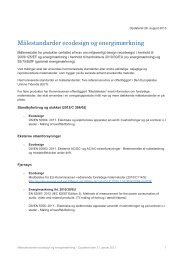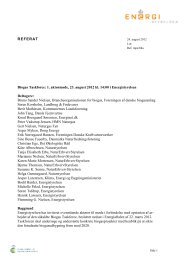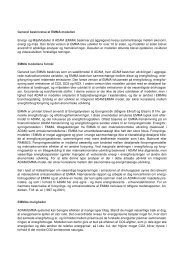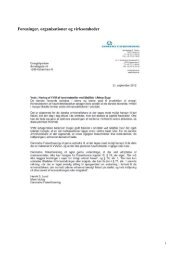Benthic Communities at Horns Rev Before, During and After Con
Benthic Communities at Horns Rev Before, During and After Con
Benthic Communities at Horns Rev Before, During and After Con
Create successful ePaper yourself
Turn your PDF publications into a flip-book with our unique Google optimized e-Paper software.
<strong>Horns</strong> <strong>Rev</strong>. <strong>Benthic</strong> communities Page 68<br />
Even though the edible crab (Cancer pagurus) only constituted less than 1% of the total<br />
abundance, this species showed some interesting characteristics. In March, Cancer pagurus<br />
generally showed a very sc<strong>at</strong>tered distribution; although juveniles were registered in<br />
rel<strong>at</strong>ively low numbers <strong>at</strong> all depth zones <strong>at</strong> the monopiles, larger individuals were less<br />
frequently observed by divers along the transect surveys than in the September surveys. In<br />
September large numbers of juveniles were found in all depth zones <strong>at</strong> the monopiles<br />
(Figure 3.27). The highest mean abundance of 950 ind./m 2 was found in depth zone 1-3 m<br />
in September 2004 <strong>and</strong> abundances over 1,900 ind./m 2 were registered <strong>at</strong> turbine site 55.<br />
From 2003 to 2005, a considerable increase in total biomass was found for Cancer pagurus,<br />
which was a result of increasing abundance <strong>and</strong> an increase in average individual<br />
body weight from 1.52 mg(dw) in September 2003 to 44.16 mg(dw) in September 2005.<br />
The average individual body weight of the initial popul<strong>at</strong>ion of Cancer pagurus <strong>at</strong> the<br />
monopiles in March 2003 was 17.52 mg(dw). In March 2005, three size classes of juvenile<br />
crabs were found. One probably representing the 0 group from 5-11 mm, the second representing<br />
the 1+ group from 20-23 mm <strong>and</strong> the third probably representing the 2+ group<br />
from approxim<strong>at</strong>ely 40 mm.<br />
0 m<br />
0-1 m<br />
1-3 m<br />
3-5 m<br />
5-7 m<br />
>7 m<br />
Cancer pagurus<br />
March 03<br />
Sept. 03<br />
March 04<br />
Sept. 04<br />
March 05<br />
Sept. 05<br />
0 100 200 300 400 500 600 700 800<br />
No/m²<br />
Figure 3.28.Depth distribution of Cancer pagurus <strong>at</strong> the<br />
monopiles.<br />
Photo 16. Adult Cancer pagurus <strong>at</strong> the scour protection..<br />
Juveniles of other crab species like the masked crab (Corystes cassivelaunus), the long<br />
clawed porcelain crab (Pisidia longicornis) <strong>and</strong> the bristly crab (Pilumnus hirtellus) were<br />
occasionally found on the monopiles. Also juveniles of the northern sea urchin (Strongylocentrotus<br />
droebachiensis) were found in low numbers.<br />
Only an insignificant contribution to the total biomass of less than 0.5% was made by the<br />
sea anemones Metridium senile, Sargartia elegans, Sargartiogeton lacer<strong>at</strong>us <strong>and</strong> Urticina<br />
feline, although they all were found on the monopiles. They were locally found in a combined<br />
coverage up to 45% with a biomass (dw) contribution of more than 50%. The most<br />
common was Metridium senile <strong>and</strong> the combined coverage of the sea anemones increased<br />
<strong>at</strong> the monopiles with increasing depth.<br />
Rel<strong>at</strong>ively high coverage in all depth zones <strong>at</strong> the monopiles, locally up to 50%, were also<br />
found for the o<strong>at</strong>en pipes hydroid (Tubularia indivisa). The pred<strong>at</strong>or of this species, the<br />
sea slug (Facelina bostoniensis), together with other sea slugs Polycera quadriline<strong>at</strong>a,<br />
Aeolidiae papillosa <strong>and</strong> Onchidoris muric<strong>at</strong>a were rel<strong>at</strong>ively abundant <strong>and</strong> frequently recorded.<br />
Doc. No. 2572-03-005 rev. 4

















